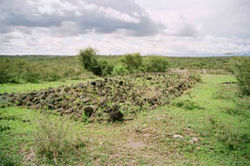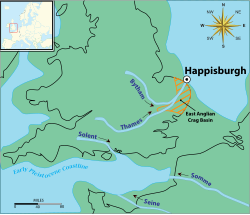Laetoli

Laetoli is a site in Tanzania, dated to the Plio–Pleistocene. It is famous for its hominin footprints, preserved in volcanic ash. The site of the Laetoli footprints is 45 km south of Olduvai gorge. It was excavated by archaeologists Louis and Mary Leakey in 1978. “The Laetoli Footprints” got a lot of attention from the public because they are convincing evidence of bipedalism in Pliocene hominins.
Dated to 3.6 million years ag,o they were the oldest known evidence of hominin bipedalism. Now older evidence has been found, such as the Ardipithecus ramidus fossils.[1] The footprints and skeletal structure excavated at Laetoli were clear evidence that bipedalism evolved before enlarged brains in hominids. Although it is debated, it is believed the three individuals who made these footprints belonged to the species Australopithecus afarensis. Together with footprints were other hominin and animal skeletal remains and Acheulean artifacts (hand-axes).

After debate, it was decided that Australopithecus afarensis is the species of the three hominins who made the footprints at Laetoli. This is based on the reconstruction of the foot skeleton of a female A. afrarensis hominin.[2] Detailed footprint analysis compared both human and bipedal animals such as bears and primates. Gaits (stride pattern), and foot structure were analysed. Step length, stride length, stride width and foot angle showed that A. afarensis was more human-like in gait than ape-like.[3][4]
A. afarensis, then, is an obligate bipedal hominid.[5] Its brain size was very similar to that of modern chimpanzees and gorillas. So, in one important respect it was like the genus Homo since it was bipedal. That means it was adapted to living in open woodland and savannah, not tropical rain forest. On the other hand, it had a brain about the size of an ape. This situation, where different traits of an animal evolve at different rates, is known as mosaic evolution.
Footprints in Europe

The oldest hominin footprints in Europe are in Britain. They are about 800,000 years to a million years old.[6][7] They were found on Happisburgh beach, East Anglia.
The archaeologists describe them as "the oldest known hominin footprint surface outside Africa at between ca. 1 million and 0.78 million years ago". The site in known for its preservation of sediments with early Pleistocene fauna and flora. Since 2005 flint tools have been found. This means humans occupied northern Europe at least 350,000 years earlier than was thought before.
Laetoli Media
Replica of Laetoli footprints, exhibit in the National Museum of Nature and Science, Tokyo, Japan
Three dimensional scans of experimental footprints and a Laetoli footprintContours are 1 mm. A) Contour map of modern human footprint (Subject 6) walking with a normal, extended limb gait and side view of normal, extended limb footprint.*B) Contour map of modern human footprint (Subject 6) walking with a BKBH gait and side view of BKBH print.*C) Contour map of Laetoli footprint
References
- ↑ Bipedalism can be deduced from the leg-bones and pelvis if these are known.
- ↑ White T.D. & Suwa G. 1987. Hominid footprints at Laetoli: facts and interpretations. American Journal of Physical Anthropology. 72 (4). pp. 485–514.
- ↑ Tuttle R.H; Webb D.M., & Baksh M. 1991. Laetoli toes and Australopithecus afarensis. Human Evolution'. 6 (3) pp. 193–200.
- ↑ Tuttle,' R.H. 2008. Footprint clues in hominid evolution and forensics: lessons andlLimitations. Ichnos. 15 (3-4), pp. 158–165.
- ↑ 'Obligate' means it only walks using its legs, never with the hands on the ground.
- ↑ Ghosh, Pallab 2014. Earliest footprints outside Africa discovered in Norfolk. BBC News Science & Technology. [1]
- ↑ Ashton, Nick et al 2014. Hominin footprints from early Pleistocene deposits at Happisburgh, UK. PLoS One.[2]



